EQUINE WELFARE NETWORK PROFILE
Bagaduce River Equine Rescue
https://bagaduceriverequinerescue.weebly.com
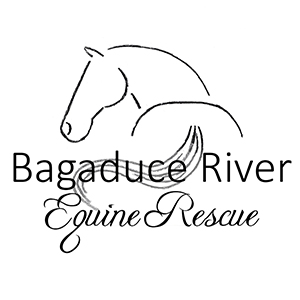
Bagaduce River Equine Rescue
111 Bagaduce Road
Brooksville, ME 04617
Mailing Address:
45 Sage Lily Rd
BROOKSVILLE, ME 04617
Phone: 207-632-5560 MAKE AN INQUIRY
View our WEBSITE
View our GUIDESTAR PROFILE
EIN: 83-2554825Founded: 2018
View our PHOTO GALLERY
Profile Last Updated March 20, 2024Public Charity
MISSION & PROGRAMS
Mission:Bagaduce River Equine Rescue's mission is to provide food, shelter, farrier and veterinary care to horses and donkeys in need and find safe, knowledgeable homes after rehabilitation. For those horses that are unable to find forever homes, we offer sanctuary for the remainder of their lives.
Our organization provides programs involved with equine rescue, adoption & retirement
Our organization provides community outreach and/or public education programs involving horses.
Our organization is directly responsible for the care and shelter of some of the equines involved in our programs and some of the equines in our programs are cared for and sheltered by other organization(s).
100% of our total programs and services are equine-related.
Our organization CURRENTLY uses satellite, overflow, foster, and/or outreach facilities which adhere to all the policies, procedures and practices of our organization. Facility information is provided for the organization's main, satellite and overflow facilities.
Summary of organization's recent accomplishments, goals, strategies to achieve the goals, and capabilities to meet the goals, including its long-term plans to sustain its programs:
Accomplishments
In the past year Bagaduce River Equine Rescue has rescued and rehabilitated many horses in need, further developed our 501c3, made major improvements to our facility, participated in several community outreach events, and hosted numerous volunteers. Our organization has grown from a small local equine rescue to a well-known and respected organization that partners with animal control officers, other rescues, veterinarians, trainers, and volunteers to help save Maine equines.
After obtaining our 501c3 non-profit in 2018, we have worked to further our organization’s long-term sustainability. We put out a call to the community and established our hard-working board of directors this past year. The board members meet regularly to discuss financials, future goals, and immediate needs. One of the first projects overseen by our new board of directors was drainage and footing improvements to the pastures and riding arena. We brought in 2 loads of pea stone to ensure our equines have a dry place to live and areas for year-round training.
We believe community education and outreach can help prevent horses from ending up in need of rescue. Therefore, we have spent the past year developing numerous opportunities for volunteers, youth groups, and students to visit the rescue and learn about horse handling and care. This past year we hosted a group of elementary students for an Afternoon of life at the Rescue, individuals from the Trekkers organization (an organization that mentors youth through outdoor activities) and trained and oversaw 8 volunteers. In addition to this, we also hosted a group of independent study students from a local high school and taught them horse handling and care. Many of our students and volunteers have little to no equine experience, and so we focus on safety for our participants, and comfort for our equines. Part of our public education goals are to consider the past experiences of the individual horse and to teach our volunteers to listen and respect the horses’ needs. Empathy, patience, understanding, and awareness are skills we try to instill in our visitors.
This past year we took on 8 new equine rescues, cared for 10 permanent sanctuary horses, rehomed 5 individuals, and checked in with 25 previously adopted equines to ensure they are still getting the care they need. All horses in our care get an individualized diet, appropriate forage for their age and dental status, routine farrier, dental, and veterinary care. We also started a new relationship with an organization called Horses With Hope, an organization dedicated to training rescue horses to ensure they have a better future. Although we work daily with each horse on handling, groundwork, and farrier and veterinary skills, we are not currently equipped to train horses to ride. When we take in a horse that is healthy enough to be ridden, we want a way to give them additional skills that will make them more adoptable. We partnered with Horses With Hope to help train 2 horses this past year.
Short term goals
Our immediate goals are to continue to improve infrastructure, expand our public outreach, create a euthanasia fund, develop a foster program, and create an online resource for equine owners in the area. We have made significant improvements to the footing in our pastures but would like to expand this project to improve drainage and footing in individual paddocks and larger sections of the pasture. In addition to improved footing, we also plan to replace and improve fencing to ensure our horses are safely contained. Our board of directors is currently in the early stages of planning three separate, affordable, one-day clinics this summer to bring training and horsemanship to members of our community. We have hosted similar clinics in the past and had several equine professionals volunteer their time leading information and training sessions for the general public. We plan to partner with several of the equine trainers we have a relationship with lead these clinics. We also plan to begin a foster program so that we can provide temporary placement for equines in emergency situations even when our facility is full. We are in the early talks with a few individuals that have expressed interest in offering their facilities for our foster program.
Even though Maine has one of the largest rates of horses per capita in New England, many equine owners lack resources, education, and support. Coupled with this is the fact that Maine is the most economically depressed New England state and large animal professionals are stretched thin trying to cover large areas. To combat some of these issues, and to keep horses in healthy loving homes, we plan to create an online database of helpful resources for equine owners in the state. This will include information on how to handle common equine emergencies, how to plan and process euthanasia, lists of equine professionals, as well as how to report animal neglect and cruelty.
Long term goals & future growth
Our long-term goals include purchasing and developing a second location so that we can take in more horses in need. This second location will become our primary rescue and rehabilitation site, with our current location focused on our sanctuary residents. Future plans include hiring staff members to oversee and supervise the new primary facility. This new site will give us room to expand our reach in the state and help additional neglected and abused equines. To accomplish this, we will purchase / lease / fund this project through capital campaign, private donations and help from the Maine Farm Trust. This will ensure that this land can never be developed and will remain available for equines in need to find a soft landing for years to come. Our vision of educating not only the public but current and future horse owners will remain a high priority for the life of our organization. Buying farmland with larger acreage for pastures will help reduce our summer hay needs and ultimately make our rescue more self-sufficient. By developing a hard-working board, collaborating with other Maine rescues, and developing a second satellite location, we hope to ensure that BRER lives on past our current situation and will outlive all of us – leaving a legacy behind.
Equine Transition Services:
Overview of our programs involved with rescue, rehabilitation, retraining, re-homing and/or retirement:
We at BRER not only rescue from killpens, but also purchase at risk horses at auctions before they reach the killpens. We accept owner surrenders and search out horses for sale that are at risk. After quarantine if needed, they are brought to our barn and allowed to breath, acclimate and adjust for as long as they need. They are fed, watered and allowed to just live for the moment, while the whole time we evaluate their personalities. We give them as much time as they need to recover from whatever situations they have been in, working closely with a trainer and giving each horse individual attention as they require. When they are in a safe place in their minds and bodies, we begin searching for their forever barn. For some, the task of rehoming, having them adjust yet again to another life, is beyond what we will ask of them, these horses need to simply find a soft landing and they will stay with our small herd for as long as they live. We believe humane euthanasia is a way of rescuing those animals that would otherwise live in pain or fear that could not be overcome. We work hard to learn the individual personalities and will only place in a new home if the match will be mutually beneficial.
Community Outreach and/or Public Education:
Our goal is to educate the public about over breeding, flipping of horses, humane euthanasia and the neglect and abuse that some horses experience because of lack of a knowledge. We try hard to give unbiased information about the plight of our nation's unwanted horses. We educate the public about where their horse may end up if they are taken to an auction. We also advocate for humane euthanasia and will help owners with the cost if needed. As our rescue becomes larger and more of a community run organization, we are developing a large following on social media. We reach out to local groups for field trips and ‘meet and greet’ get togethers. We find that by telling the story of each horse, their personalities and their experiences, our social media supporters will follow their story and this gives us the opportunity to educate the public through the horses voice.
Research/Medical Use of Equines:
Our organization has made equines available for research studies or medical training.
Please explain where and for what purpose equines are/were provided to use in research or medical training.
We have never had any of our equines used for research or medical training, however, if we could help with research or training that did not involve invasive procedures or cause pain or suffering, we would definitely consider doing so.
Religious Affiliation:
Our organization does not promote religious education, religious purposes, or a specific religious faith or use donations for religious education or religious purposes; require participants to be of a certain faith; require participation in religious, instruction, activities or services; or require participation in prayer, worship, religious instruction or other religious activities as a condition of receiving social or secular services offered.
Auction Donation:
Our organization has never allowed, or would not consider allowing, an equine to be sold, transferred, released, or otherwise placed into possession of any person or organization that would cause or allow the equine to be sold at auction for slaughter.
POLICIES: ACQUISITION
Our organization acquires horses/equines from the following source(s):
Purchase from Owner
Auction
Kill pen/Feedlot
Return
Surrender
Seizure
Abandonment
Our organization does not acquire horses/equines from the following source(s):
Donation
Lease
Our organization will accept the following:
Geldings
Mares
Pregnant Mares
Foals
Not Checked:
Stallions
Only Stallions to be castrated
Additional information about our acquisition policies and practices:
We will accept all breeds without question. The one requirement is we will have stallions gelded before they arrive.
POLICIES: INTAKE, ASSESSMENT & TRAININING
Prior to a horse being accepted and/or arriving at the facility, the organization requires the following with respect to the health status of the horse:If health records are not available or are out-of-date, our veterinarian will administer appropriate vaccinations
Not Checked:
A current Coggins
Vaccination records that have been administered within the last 12 months
If health records are not available or are out-of-date, the owner is responsible for having vaccinations administered.
A health certificate signed by a veterinarian and dated no more than seven days prior to arrival is provided to our organization either prior to or upon arrival of the equine attesting to the health status of the equine
A current Coggins
Vaccination records that have been administered within the last 12 months
If health records are not available or are out-of-date, the owner is responsible for having vaccinations administered.
A health certificate signed by a veterinarian and dated no more than seven days prior to arrival is provided to our organization either prior to or upon arrival of the equine attesting to the health status of the equine
Prior to a horse being accepted and/or arriving at the facility, the organization has the following policies in place:
The owner of a potential equine is interviewed over the phone or in person prior to seeing the equine
The equine is evaluated at its place of residence
The owner completes an application/contract which constitutes the agreement between the owner and our organization
Equines are not taken on trial
Not Checked:
The owner is financially responsible for the shipping of the equine to and from the organization
The owner is financially responsible for the shipping of the equine to and from the organization
Following arrival of the equine at the facility, the following is performed:
Physical examination by trained barn staff
Photographs are taken of each equine upon arrival at the facility and kept with the equine's health records
Physical examination by a farrier
Physical examination by a dentist
Coggins test
Blood work other than Coggins
Fecal test
Vaccinations
De-worming
Not Checked:
Physical examination by a veterinarian upon arrival
A Henneke Body Conditioning Score or other body conditioning score is assigned
The equine is scanned to check for a microchip
The equine is microchipped if the scan indicates that there is no microchip
Physical examination by a veterinarian upon arrival
A Henneke Body Conditioning Score or other body conditioning score is assigned
The equine is scanned to check for a microchip
The equine is microchipped if the scan indicates that there is no microchip
Upon intake, the organization has the following quarantine policy in place:
The equine is confined to a designated and separate area for isolation and quarantine at the facility for a prescribed period of time
The equine is confined to a designated and separate area for isolation and quarantine off-site for a prescribed period of time
Not Checked:
The equine is not quarantined
The equine is not quarantined
The typical length of quarantine is: 20 to 30 days
Horses are assessed for following skills and behaviors:
Retrieval from a pasture/paddock
Leading with a halter and lead rope
Temperament, disposition and attitude, such as rated from very calm to very high spirited
Saddling
Bridling
Lunging
Loading onto and unloading off a trailer
Mounting and dismounting
Riding at the walk
Riding at the trot
Riding at the canter
Riding by a beginner and/or unbalanced rider
Jumping
Driving (Pulling a carriage)
Tolerance to unusual objects and loud noises
Known vices, i.e., cribbing, biting, kicking, weaving, stall walking, etc
Grooming
Bathing
Clipping
Tolerance to multiple handlers at the same time
Not Checked:
Our organization has the following policies and procedures in place pertaining to the ongoing assessment of horses in its care:
Physical examination by a veterinarian at least annually
Photographs are taken of each equine monthly and kept with the equine's health records
Photographs are taken of each equine annually and kept with the equine's health records
Equines at our facility may be treated by an equine chiropractor
Equines at our facility may be treated by an equine acupuncturist
Equines at our facility may be treated by an equine massage therapist
Not Checked:
The Henneke Body Condition score or other body conditioning score is updated at least annually
Equines at our facility may be treated by an equine nutritionist
Our organization has the following policies and procedures in place pertaining to the weight-carrying or workload capabilities of horses/equines that are ridden in our care: The Henneke Body Condition score or other body conditioning score is updated at least annually
Equines at our facility may be treated by an equine nutritionist
Our organization evaluates at least annually and maintains a written record of the weight-carrying and workload limitations for each equine that is ridden
Not Checked:
Our organization does not evaluate the weight-carrying and workload limitations for each equine that is ridden
No equines are ridden; not applicable
Our organization does not evaluate the weight-carrying and workload limitations for each equine that is ridden
No equines are ridden; not applicable
The following variables are considered in determining the weight-carrying and workload limitations for each equine that is ridden:
Equine age, weight, breed, body condition, fitness, balance, health and soundness
Equine conformation to include the top line, length of back, strength and width of loin, bone density (measured by the circumference of the cannon bone just below the knee)
Size, shape, condition and angle of the hooves
Participant weight, height, body proportions, balance, fitness and riding skills as well as behavioral issues and safety concerns
Weight and proper fit of the saddle and other equipment
Terrain and footing in the working environment
Duration and frequency of working sessions, as the frequency with which an equine is subjected to maximum weight carrying and/or workload
Nature and pace of work, repetitive or varied, radius of turns, degree of incline and regularity of footing when equine is subject to maximum weight-carrying capacity
Temperature and/or weather conditions
Seasonal impact on the equines' workload and weight-carrying capabilities and limitations
Not Checked:
Our organization does not evaluate the weight-carrying and workload limitations for each equine that is ridden
No equines are ridden; not applicable
Our organization does not evaluate the weight-carrying and workload limitations for each equine that is ridden
No equines are ridden; not applicable
Horses provided formal training (groundwork or riding): As needed; no set schedule
Additional information about our intake, assessment & training policies and practices:
We work closely with a local trainer to evaluate each horse's abilities before placing them in a new home. We want the transition to go smoothly and successfully, therefore, we are open about all issues that may arise. We quarantine off site for those equine that have a high risk of exposure to contagious disease. If the horse/donkey has been in relative confinement in its previous location, we quarantine on site.
POLICIES: BREEDING
The organization has the following policies related to breeding and stallions:Our main facility where our organization conducts its programs does NOT breed equines.
Not Checked:
One or more of the facilities where our organization conducts its programs, including foster facilities, breeds equines
One or more of the facilities where our organization conducts its programs, including foster facilities, are permitted to house stallions
One or more of the facilities where our organization conducts its programs, including foster facilities, breeds equines
One or more of the facilities where our organization conducts its programs, including foster facilities, are permitted to house stallions
POLICIES: EUTHANASIA
The organization has the following policies related to euthanasia:Our organization will never have an equine euthanized for space
Our organization will have an equine euthanized upon the recommendation of the veterinarian if the equine is a threat to itself, other equines, or people
Our organization will have an equine euthanized upon the recommendation of the veterinarian after all reasonable treatment options have been explored
Euthanasia is done on site when possible to decrease trauma from transport
Disposal of the carcass is handled within 24 hours
Not Checked:
Our organization will never have an equine euthanized under any circumstances
Euthanasia is done at the veterinarian's facility
Our organization will never have an equine euthanized under any circumstances
Euthanasia is done at the veterinarian's facility
The following are authorized to administer the procedure for your organization in accordance with state laws:
Veterinarian
Not Checked:
A certified euthanasia technician
Senior staff with appropriate training
Employee of animal control shelter or humane society with appropriate training
Veterinary student under the supervision of a licensed veterinarian
Not applicable. Our organization prohibits euthanasia under any circumstances
A certified euthanasia technician
Senior staff with appropriate training
Employee of animal control shelter or humane society with appropriate training
Veterinary student under the supervision of a licensed veterinarian
Not applicable. Our organization prohibits euthanasia under any circumstances
Additional information about our euthanasia policies and practices:
In an emergency and under the verbal guidance of a certified veterinarian, we would allow euthanasia of a horse by gunshot to the brain by a person qualified and experienced in this procedure, however, we have never had to administer euthanasia by this method to date.
POLICIES: RE-HOMING
View Re-homing AgreementOur organization has the following re-homing (adoption/purchase) policies and procedures in place:
All potential adopters/purchasers complete a written contract which constitutes the agreement between our organization and the new owner
Our organization will only re-home an equine to a location where another equine resides
Potential adopters/purchasers must visit our organization and be observed with the equine on site
The distance of a potential adopter/purchaser's home from our facility is a consideration for when re-homing an equine
Our organization conducts a site visit of the adopter/purchaser's facility before the transfer of the equine to the adopter/purchaser's facility
Potential adopters/purchasers are encouraged to do a short-term, on-site foster with the equine
Not Checked:
Our organization does NOT re-home an equine to first time equine owners
Adopters/purchasers are NOT required to provide updates
Our organization does NOT re-home an equine to first time equine owners
Adopters/purchasers are NOT required to provide updates
Our organization has the following policies and procedures related to horses that need to be retired, are no longer able to contribute to the mission of the organization, and/or are no longer manageable:
Equines may remain at our organization for their lifetimes
Equines may be found suitable homes by our organization
In the case an equine is unmanageable and demonstrates repeated dangerous behaviors, the equine may be euthanized upon the recommendation of the veterinarian
In the case an equine is unsound and/or unhealthy and cannot be treated to relieve suffering, the equine may be euthanized upon the recommendation of the veterinarian
The organization will accept financial responsibility for equines in the current care of the organization that need to be retired or are no longer able to contribute to the mission of the organization if all alternatives have been explored to find the equine an appropriate placement and space is not available for the equine to remain at the organization.
Not Checked:
Equines may be returned to their owners
Equines may be sent to auction
If a suitable home cannot be located within 12 months, the equine may be euthanized
Equines may be returned to their owners
Equines may be sent to auction
If a suitable home cannot be located within 12 months, the equine may be euthanized
The uploaded Re-homing agreement includes the following re-homing (adoption/purchase) statements:
The agreement states that the re-homed equine CANNOT be sold, adopted, transferred, auctioned, released, given away, or otherwise placed into the possession of another individual or organization under any circumstances and must be returned to our organization should the adopter decide that he/she is no longer able, or no longer wishes, to care for the equine.
The agreement reflects that any individual or organization in possession of the equine as of the date of the agreement and any time thereafter is bound to not sell the equine at auction for slaughter or allow the equine to be sold, transferred, released, or otherwise placed into possession of any person or organization that will cause or allow the equine to be sold at auction for slaughter.
The agreement states that re-homed equines cannot be bred
The agreement states that if there is any breach of contract the equine must be returned to our organization
The agreement states that our organization reserves the right to make unannounced visits
The agreement states that adopters/purchasers can return an equine to our organization free of charge
Not Checked:
The agreement states that should the adopter decide to re-home the equine, our organization must be notified of the name, address, and telephone number of any individual or organization intending to take possession of the equine for any reason prior to the equine being placed into the possession of such individual or organization.
The agreement states that should the adopter decide to re-home the equine, our organization must grant approval of any individual or organization intending to take possession of the equine for any reason prior to the equine being placed into the possession of such individual or organization, including being provided written notification of the name, address, and telephone number of any individual or organization intending to take possession of the equine for any reason.
The agreement states that the terms of our organization's agreement will be binding on any future individual or organization taking and/or in possession of the equine for any reason.
The agreement states that our organization reserves the right to make scheduled visits
The agreement states that adopters/purchasers can return an equine to our organization for a fee
The agreement states that adopters/purchasers are required to provide updates (photos, vet records) for one year
The agreement states that adopters/purchasers are required to provide updates (photos, vet records) for two years
The agreement states that adopters/purchasers are required to provide updates (photos, vet records) for three or more years
None of the statements are included.
The organization does not re-home equines under any circumstances; our organization retains custody of our equines and ensures care of the equines for their lifetimes.
Our organization does not have the authority to transfer ownership and/or does not own any of the equines involved with our programs.
The agreement states that should the adopter decide to re-home the equine, our organization must be notified of the name, address, and telephone number of any individual or organization intending to take possession of the equine for any reason prior to the equine being placed into the possession of such individual or organization.
The agreement states that should the adopter decide to re-home the equine, our organization must grant approval of any individual or organization intending to take possession of the equine for any reason prior to the equine being placed into the possession of such individual or organization, including being provided written notification of the name, address, and telephone number of any individual or organization intending to take possession of the equine for any reason.
The agreement states that the terms of our organization's agreement will be binding on any future individual or organization taking and/or in possession of the equine for any reason.
The agreement states that our organization reserves the right to make scheduled visits
The agreement states that adopters/purchasers can return an equine to our organization for a fee
The agreement states that adopters/purchasers are required to provide updates (photos, vet records) for one year
The agreement states that adopters/purchasers are required to provide updates (photos, vet records) for two years
The agreement states that adopters/purchasers are required to provide updates (photos, vet records) for three or more years
None of the statements are included.
The organization does not re-home equines under any circumstances; our organization retains custody of our equines and ensures care of the equines for their lifetimes.
Our organization does not have the authority to transfer ownership and/or does not own any of the equines involved with our programs.
Our organization requires references from the following:
Veterinarian
Farrier
Personal/Other
Not Checked:
Not applicable or no references required.
Not applicable or no references required.
Transfer of ownership occurs: Our organization retains ownership of the equine for its lifetime
The average equine re-homing (adoption/purchase) fee received by your organization:
Not applicable; None received
Additional information about our rehoming policies and practices:
Our 'at capacity' limit ensures that all horses and donkeys at our facility have large pastures to live and each have a stall if needed. In the case of a returned animal and we are at capacity, we have several options. One is to divide one of our paddocks into a smaller temporary living space until a larger area can be constructed. Each of our paddocks have run in shelters that can house extra horses if needed. We also have several foster homes that are willing to take in a horse on an emergency, short term basis, providing us the time to create a suitable space at our barn.
EQUINE CARE & SHELTER/FACILITY INFORMATION
Total facilities at which our organization cares for and shelters horses used in our programs: 2Our organization CURRENTLY uses satellite, overflow, foster, and/or outreach facilities which adhere to all the policies, procedures and practices of our organization. Facility information is provided for the organization's main, satellite and overflow facilities.
Bagaduce River Equine Rescue
111 BAGADUCE RD Brooksville ME 04617
Contact: Kelly Saunders
Contact's Phone: 207-632-5560
Contact's Email: saundersnah@hotmail.com
Currently operational
Total number of horses/equines currently involved with your programs, under your care, and/or owned by your organization at this facility: 12
Total number of horses at this facility INCLUDING those counted above: 12
Maximum capacity of horses at this facility: 12
Does your organization own, lease or use a part of this facility? Use
Provide the contact information for the individual or organization responsible for investigating abuse in the county where the facility is located, including mailing address, email address, and phone information.
Douglas Radziewicz 287-3846 Douglas.Radziewicz@maine.gov District Humane Agent, Animal Welfare Program, Dept. of Ag. 28 State House Station, Augusta, Me., 04333
Does your organization conduct Equine Assisted Services (EAS) at this facility in accordance with the EQUUS Foundation Guidelines on Qualifications of Organizations Conducting Equine Assisted Services (EAS)? No
Bagaduce River Equine Rescue
Veterinarian Information
Veterinarian: Dennis Ruskinis
Clinic Name: Foxcroft Large Animal Associates
1441 Dexter Rd
Dover Foxcroft ME 04426
Phone: 207-717-3023
Overview: Bagaduce River Equine Rescue (*Main)
Total number of horses/equines currently involved with your programs, under your care, and/or owned by your organization at this facility: 12
Total number of horses at this facility INCLUDING those counted above: 12
Maximum capacity of horses at this facility: 12
Total acreage dedicated specifically to the horses: 10
Our organization has use of the following at this facility:
Structures/Barns: 2 Run-in sheds: 1
Pastures: 1 Paddocks/Pens/Turnout Areas: 2
Uncovered Outdoor Rings: 1 Covered Outdoor Rings: 0 Indoor Rings: 0
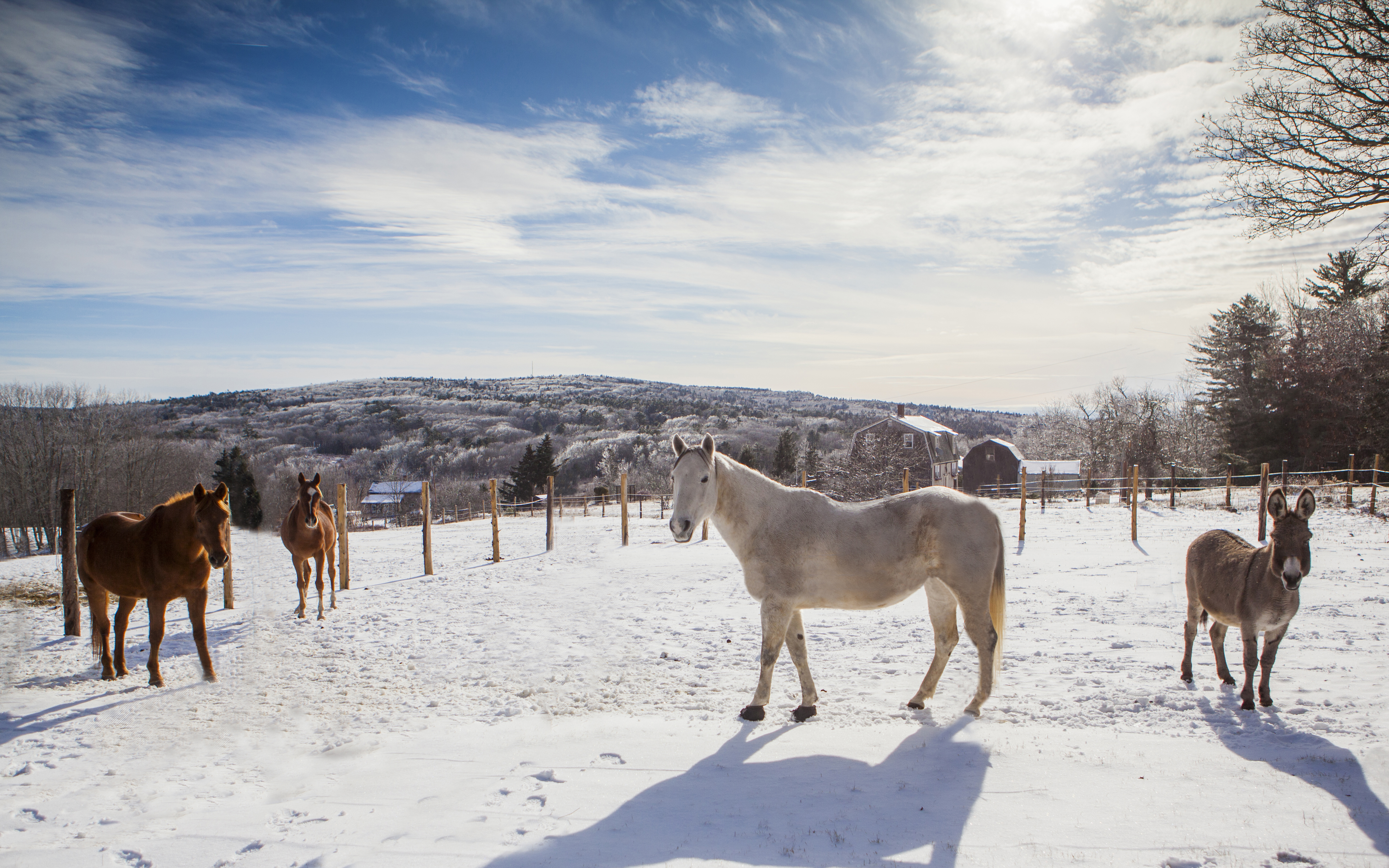
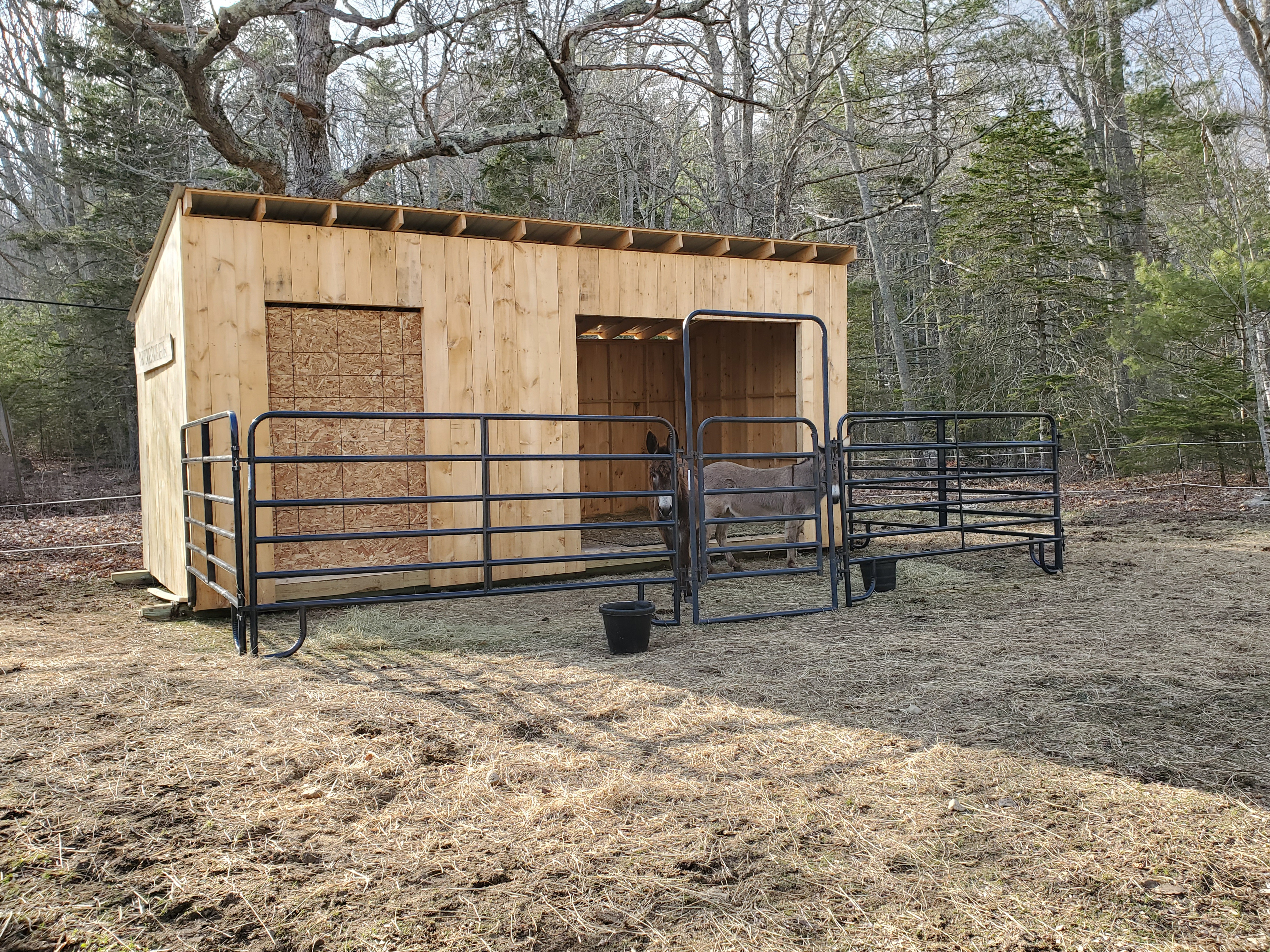
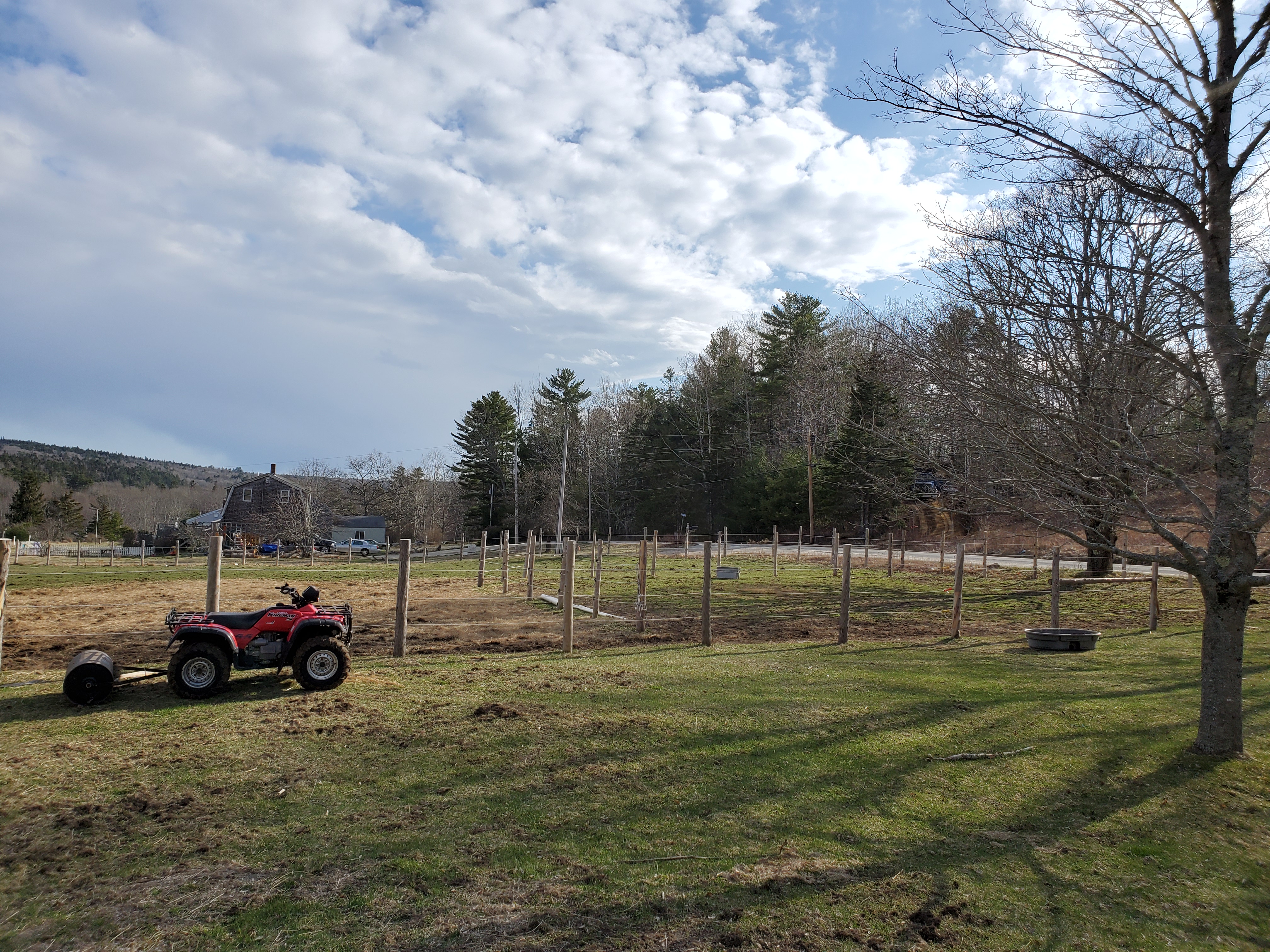
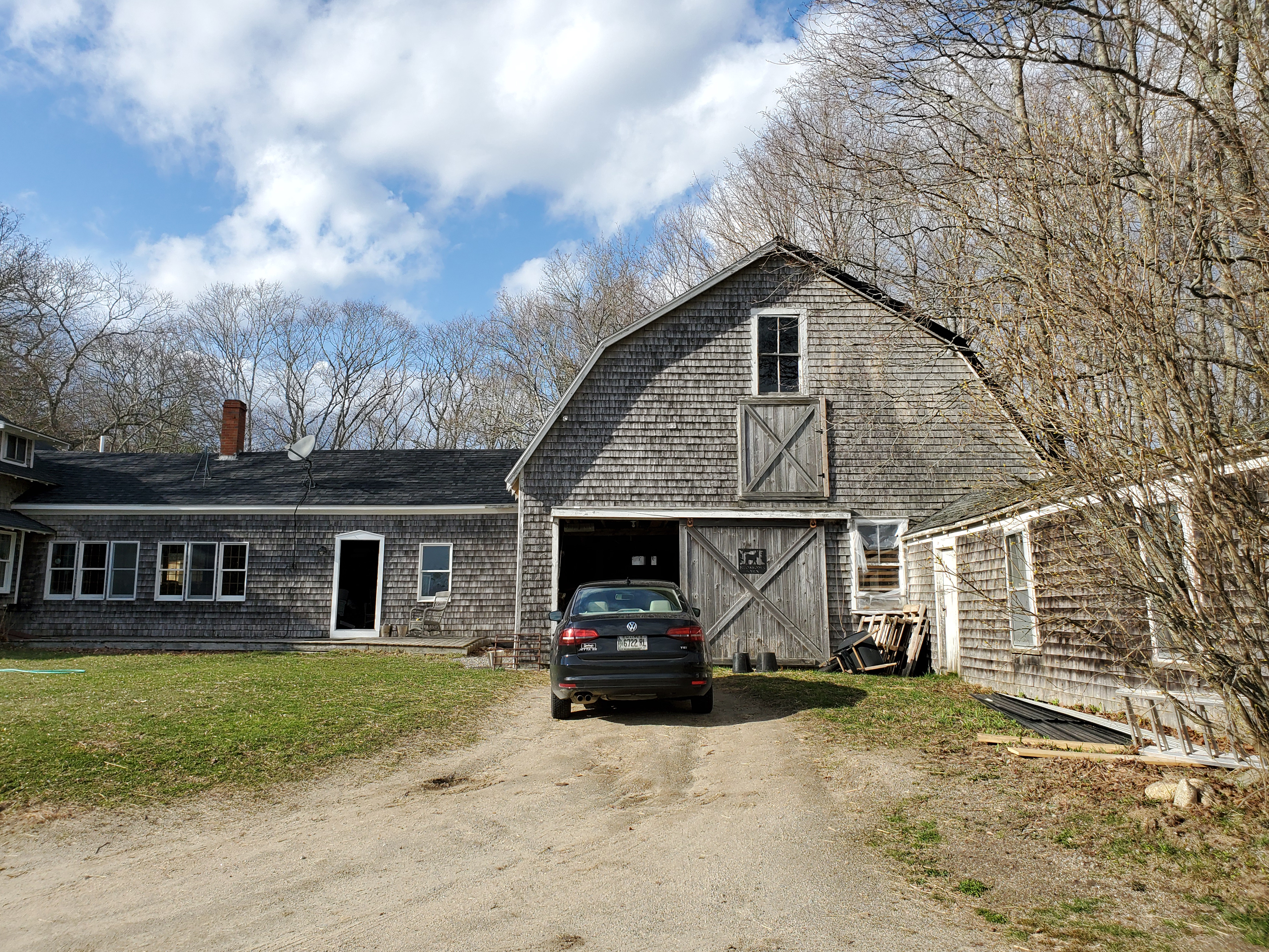
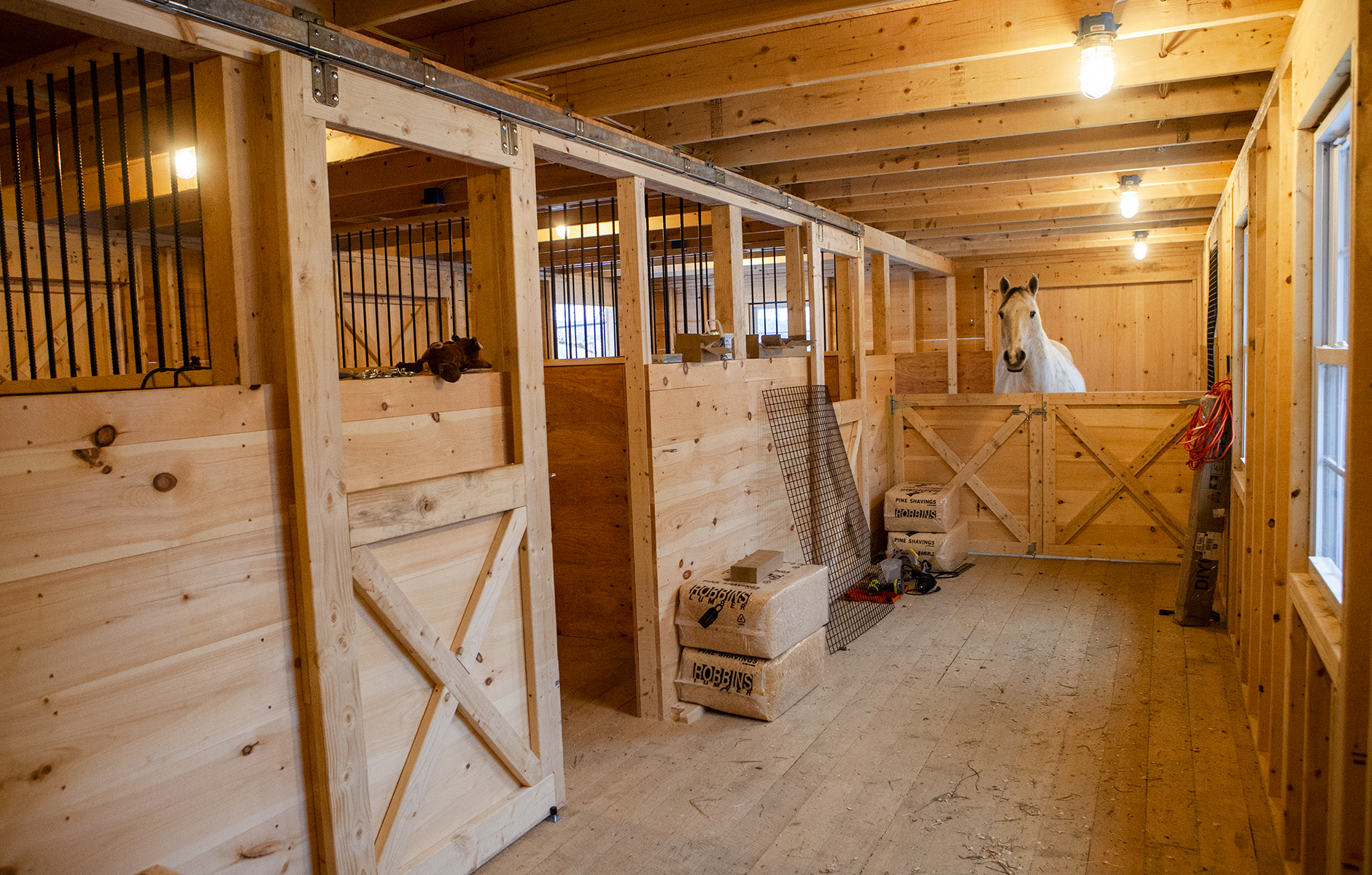
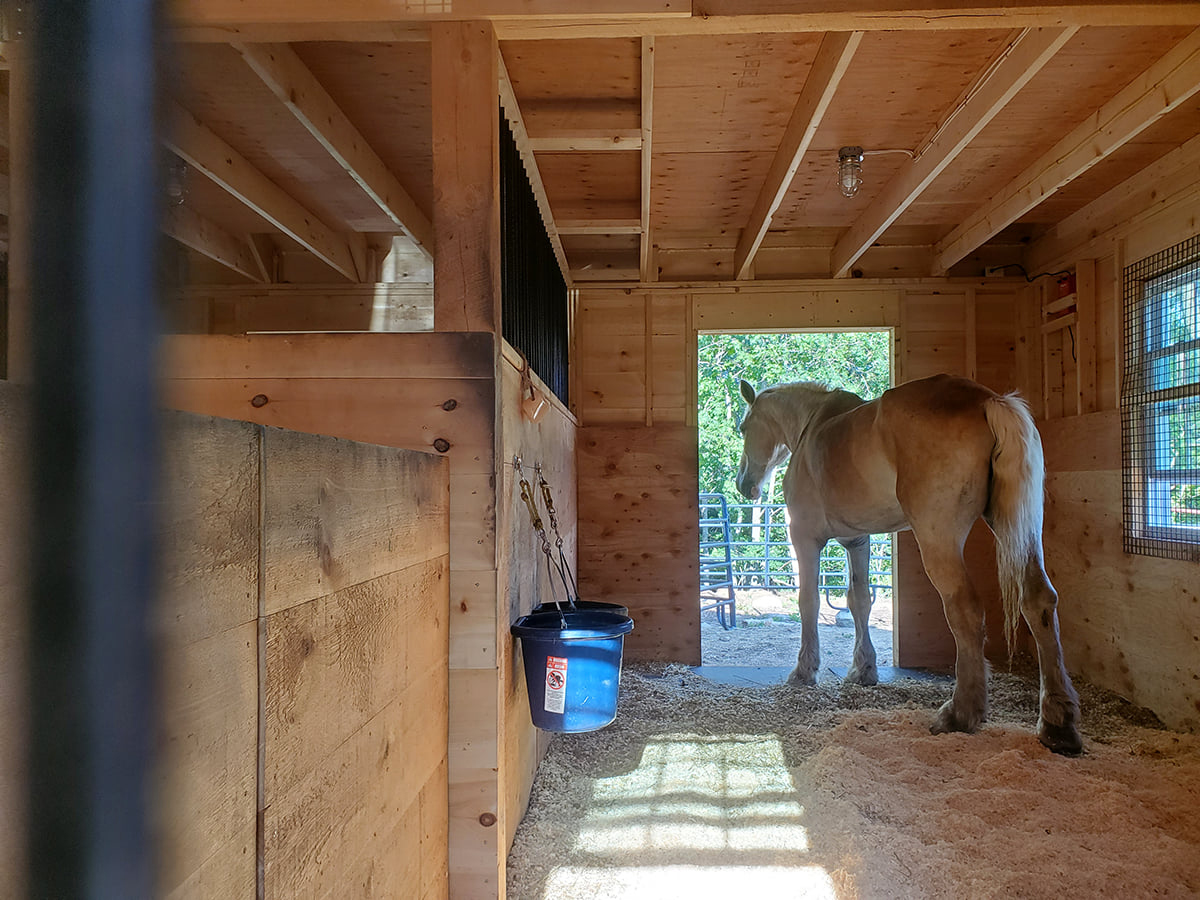
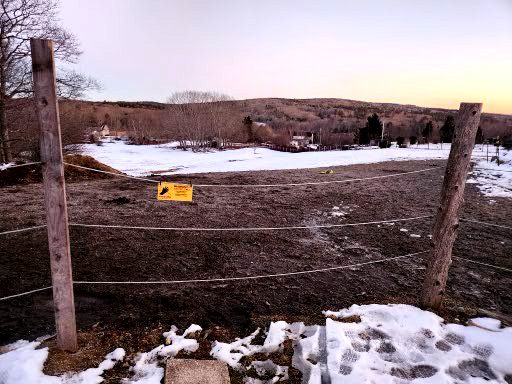
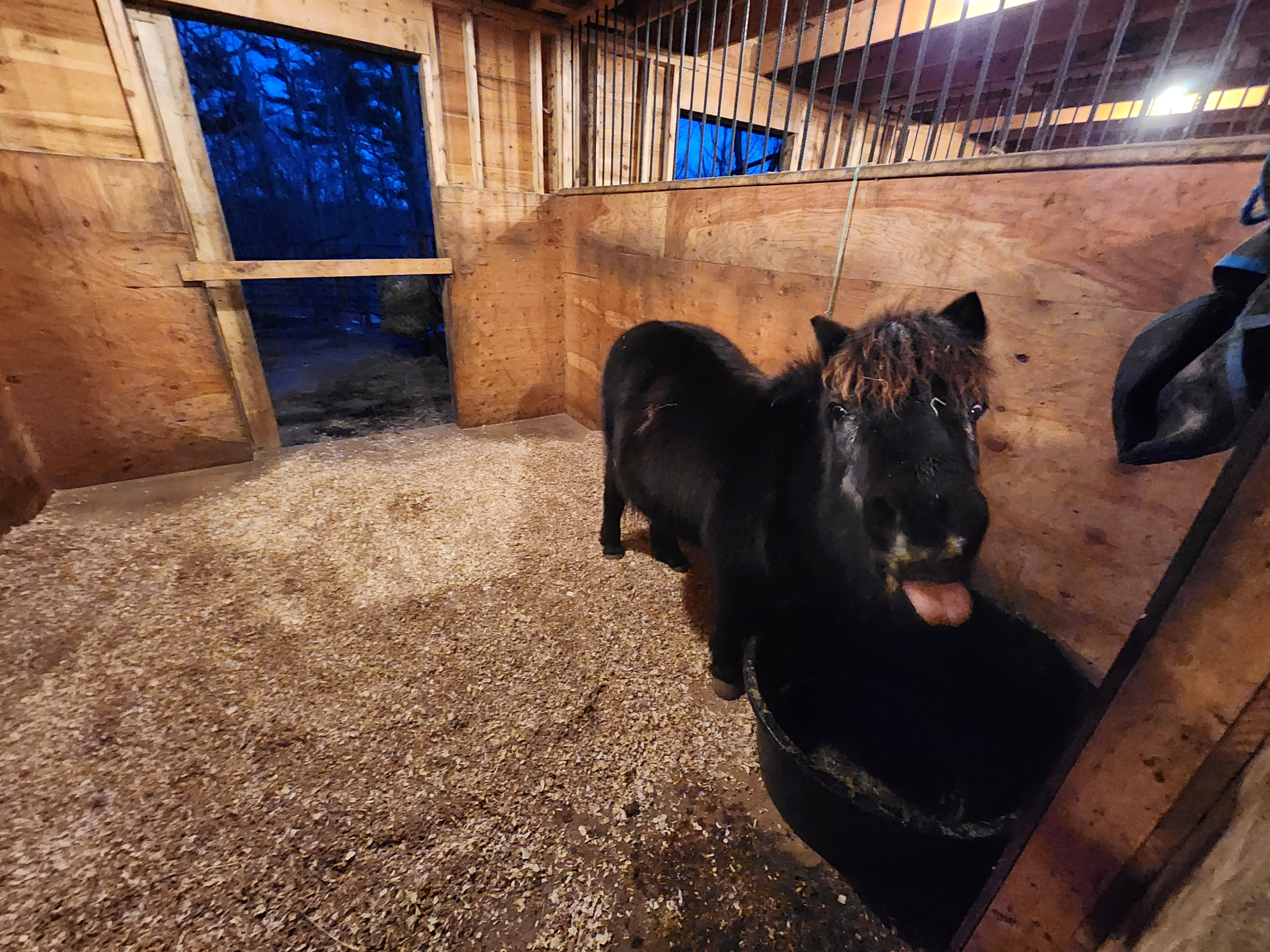
Regarding structures at this facility where horses are stalled:
Do horses have assigned stalls in the structure(s)? Yes
Do all stalls/enclosures allow horses to lie down, stand up and turn around? Yes
Is there adequate ceiling & beam height (a minimum of 12 feet above the tip of the horse's ear) when standing in all stalls/enclosures? Yes
How often are the stalls/enclosures cleaned? 6-7 Days a Week
Are floors constructed and maintained for both good drainage and traction? Yes
Is there a ventilation and circulation system in place to control temperature and prevent buildup of toxic gases? Yes
Is wiring inaccessible to horses and maintained for safety? Yes
Are fire prevention/protection measures (fire alarms, extinguishers and sprinkler systems) maintained and in good working order? Yes
Is there adequate lighting to ensure safety in all areas of facility? Yes
Are emergency contacts, including veterinarian contact information, conspicuously posted in easily accessible locations? Yes
Are human and equine first aid kits easily accessible? Yes
How many hours per day, on average, are horses stalled? 9-12
How many hours per day, on average, are horses turned out:
Equines are out 24/7
The following describes the pastures at this facility:
A dedicated staff person(s) is responsible for pasture management
All pastures are fenced to prevent escape or injury
Electric fencing is used; electric wires or tape fence are visibly marked
Fencing checks, such as broken or missing planks, loose fence posts, exposed or loose nails, detached wires, etc., are done regularly
Pastures are rotated
Pastures have natural protection for equines (i.e., trees)
Not Checked:
This facility does not have pastures where equines can graze on pasture grass
This facility has a written plan in place for pasture management, which includes guidelines for seeding, fertilizing, irrigation, mowing, dragging, harrowing, manure removal, removal of debris, the control of poisonous plants, and a schedule for cleaning
Barbed wire is used for fencing
Pastures have man-made protection for equines (i.e., shelters)
This facility does not have pastures where equines can graze on pasture grass
This facility has a written plan in place for pasture management, which includes guidelines for seeding, fertilizing, irrigation, mowing, dragging, harrowing, manure removal, removal of debris, the control of poisonous plants, and a schedule for cleaning
Barbed wire is used for fencing
Pastures have man-made protection for equines (i.e., shelters)
The following describes the turnout areas other than pastures at this facility:
A dedicated staff person(s) is responsible for the maintenance of turnout areas
All turnout areas are fenced to prevent escape or injury
Turnout areas have man-made protection for equines (i.e., shelters)
Fencing checks, such as broken or missing planks, loose fence posts, exposed or loose nails, detached wires, etc., are done regularly
Not Checked:
This facility does not have turnout areas
This facility has a written plan in place for the maintenance of turnout areas, which includes a schedule for cleaning, manure removal, and dragging
Barbed wire is used for fencing
Electric fencing is used; electric wires or tape fence are visibly marked
This facility does not have turnout areas
This facility has a written plan in place for the maintenance of turnout areas, which includes a schedule for cleaning, manure removal, and dragging
Barbed wire is used for fencing
Electric fencing is used; electric wires or tape fence are visibly marked
The following policies and procedures are in place at the facility to restrict public access and to keep horses safe:
The property owner, staff member or caretaker lives on the premises and ensures that public access is restricted and is responsible for the security of the facility and equines
Visitors are only permitted at specific times
Visitors are only permitted in specific areas
Not Checked:
A security guard is present at night
Equines are checked overnight
By Appointment Only signs are posted.
No Trespassing signs are posted
Hold Harmless signs are posted
Authorized Personnel Only signs are posted
Entrance gates are locked at night
The property is fitted with motion lights
The property is fitted with a security system monitored by police or a professional service
The property is fitted with a security system that is monitored internally by staff (or the property owner)
The perimeter of the property is fully fenced
A security guard is present at night
Equines are checked overnight
By Appointment Only signs are posted.
No Trespassing signs are posted
Hold Harmless signs are posted
Authorized Personnel Only signs are posted
Entrance gates are locked at night
The property is fitted with motion lights
The property is fitted with a security system monitored by police or a professional service
The property is fitted with a security system that is monitored internally by staff (or the property owner)
The perimeter of the property is fully fenced
Equine Care/Emergency Preparedness: Bagaduce River Equine Rescue (*Main) 2024 and 2023 This section is required.
Horse Health Care/Barn Management Records: What system is used to collect and store health/horse care records?
Notebook or equivalent (technology not utilized)
The following items are consistent with our feed management plan and practices:
Equines are provided with individualized feeding plans, including supplements, according to age and any health issues
Feed plans are determined in consultation with a veterinarian
Supplement plans are determined in consultation with a veterinarian
Equines are fed in individual stalls
Equines are fed in groups
Staff and volunteers are trained in proper feed measurements and protocols and observed periodically to ensure they are feeding correctly
The feed chart is centrally located and updated as needed
The area(s) where hay, feed, grain, and supplements are stored are kept clean, free of debris and chemicals, and protected from weather and other animals in rodent-proof and mold-proof containers and grain bins
Feed, supplements and hay types are clearly labeled
Water sources, i.e., buckets, troughs, automatic waterers, etc. are kept clean, free of debris and chemicals, and protected from weather and other animals
Medications are kept in a locked, climate-controlled area
Not Checked:
Do horses have access to clean drinking water at all times? Yes
Hoof Care: How often is hoof care provided for each equine? Every 4-8 weeks and when an issue arises
Dental Care: How often is dental care provided for each equine? Annually and when an issue arises
Horse checks: How often are equines visually and physically checked by personnel at the facility? Every day or 6 days a week
Parasite Control: Our organization has the following worming protocols in place: (Check all that apply
A de-wormer is used without fecal testing
Fly/Insect Control: What remedies are used to control flies and insects?
Fly Spray Repellent
The following represent the biosecurity practices in place at facility:
Our organization follows the AAEP's Biosecurity Guidelines and/or the UC Davis Biosecurity Guidelines
Our organization follows the biosecurity guidelines of our veterinarian
Sick, affected and/or quarantined equines do not have contact with other equines or other animals
The organization has a written biosecurity plan
All staff are trained in best practices related to biosecurity
All volunteers are trained in best practices related to biosecurity
A specific individual is assigned to care for sick, affected and/or quarantined equines
Sick, affected and/or quarantined equines are cared for last if the caretaker must also care for healthy equines
Sick, affected and/or quarantined equines do not have contact with other equines or other animals
Restricted access signs are posted at primary points of access to sick, affected and/or quarantined equines
Manure and bedding from sick, affected and/or quarantined equines is disposed of in specific areas designated for infectious materials - not put in open air piles, and not spread on pastures
Stalls, aisle ways, and common areas are disinfected after conclusion of the quarantine
Trailers/vans used by sick, affected and/or quarantined equines are cleaned and disinfected after each use and cleaning takes place away from where equines are sheltered
Equipment used by sick, affected and/or quarantined equines is not shared and is clearly labeled
Shared equipment used by sick, affected and/or quarantined equines is cleaned of organic debris and disinfected after each use
Personnel are required to leave the facility (or shower and change clothing) after working with quarantined equines
Not Checked:
Hand sanitizers and footbaths are available at all primary points of access to sick, affected and/or quarantined equines
Latex gloves are worn when working with sick, affected and/or quarantined equines
Equines are not quarantined on arrival.
Hand sanitizers and footbaths are available at all primary points of access to sick, affected and/or quarantined equines
Latex gloves are worn when working with sick, affected and/or quarantined equines
Equines are not quarantined on arrival.
The following represent the manure removal practices in place at facility:
Manure is piled in an area where equines are not located
Manure is hauled, sold or given away
Not Checked:
Manure is stored in dumpster(s)
Manure piles are covered
Manure piles are composted or spread on pastures
Our organization adheres to the manure management guidelines set by state and/or local authorities
Manure is stored in dumpster(s)
Manure piles are covered
Manure piles are composted or spread on pastures
Our organization adheres to the manure management guidelines set by state and/or local authorities
The following steps are taken to help staff and volunteers readily identify each horse on the property:
Equines are assigned the same stall/location each day
A notebook or binder with photos and information on each equine is easily accessible
Equine photos and profiles are available on the website
Team leaders work with new staff/volunteers until they are able to identify the equines
Not Checked:
Name plates are located on the stall
Photos are located on the stall
Equines wear halters with nametags
A map/diagram is posted showing the location of each equine with equine names and photos
Staff and volunteers are provided with an information packet with equine profiles, including photos and detailed descriptions
Staff/volunteers are provided training on conformation, markings, colors, and breeds
Name plates are located on the stall
Photos are located on the stall
Equines wear halters with nametags
A map/diagram is posted showing the location of each equine with equine names and photos
Staff and volunteers are provided with an information packet with equine profiles, including photos and detailed descriptions
Staff/volunteers are provided training on conformation, markings, colors, and breeds
Our organization has the following policies and procedures in place pertaining to tack, apparel and equipment:
Saddles are shared
Saddle pads are shared
Bridles are shared
Bits are shared
Blankets, sheets and turn out apparel are fitted and utilized for each equine appropriate to the equine's needs and the weather conditions
Blankets, sheets and turn out apparel are cleaned regularly as needed
Halters are shared
Tack is cleaned only when needed
Tack is inspected for overall working condition before each use by trained personnel
Tack is assessed for fit before each use by trained personnel
Tack is assessed for fit by trained personnel when an equine's body condition changes
Tack is assessed for fit by trained personnel when an equine's disposition changes
Helmets are replaced after a fall
Not Checked:
All equines have specifically assigned tack, apparel and equipment that is not shared
Blankets are shared
Sheets are shared
Turnout apparel is shared
Tack is cleaned after each use
Tack is cleaned weekly
This facility enlists the services of a professional saddle fitter at least once a year
Assigned tack is clearly labeled
Tack is stored in a climate-controlled location
Helmets are shared
Helmets are cleaned/disinfected after each use
Helmets are replaced at least every five years.
No equines are ridden; not applicable.
All equines have specifically assigned tack, apparel and equipment that is not shared
Blankets are shared
Sheets are shared
Turnout apparel is shared
Tack is cleaned after each use
Tack is cleaned weekly
This facility enlists the services of a professional saddle fitter at least once a year
Assigned tack is clearly labeled
Tack is stored in a climate-controlled location
Helmets are shared
Helmets are cleaned/disinfected after each use
Helmets are replaced at least every five years.
No equines are ridden; not applicable.
Emergency Preparedness: Bagaduce River Equine Rescue: *Main This section is required.
The following plans, policies, and procedures are in place at the facility to handle emergencies and address weather related issues, fire safety procedures, and/or any additional hazardous scenarios the facility could potentially experience:
Emergency procedures are posted prominently
Emergency phone numbers are posted prominently
The facility owns or has access to a generator
The facility maintains at least two weeks of hay, feed, shavings and medications
The facility maintains appropriate liability and/or workers' compensation insurance
All staff/volunteers are briefed regularly on emergency preparedness/safety procedures
The organization has a written emergency preparedness/safety plan (EPP)
Not Checked:
The facility collects and maintains medical information from staff, volunteers, and clients
The written EPP addresses the following areas: The facility collects and maintains medical information from staff, volunteers, and clients
Local fire department and/or the state's emergency planning department procedures
Medical emergencies for equines
Not Checked:
Medical emergencies for clients, staff, and volunteers
Evacuation plans
Power outages
Fire
Natural Disasters - thunderstorm, hurricanes, earthquakes, tornados, etc
Terrorist attacks
Protocols to notify emergency personnel
Building/facility exit plans
Medical emergencies for clients, staff, and volunteers
Evacuation plans
Power outages
Fire
Natural Disasters - thunderstorm, hurricanes, earthquakes, tornados, etc
Terrorist attacks
Protocols to notify emergency personnel
Building/facility exit plans
The facility follows the specific procedures to help PREVENT emergency situations:
Smoking is strictly prohibited
NO SMOKING signs are posted prominently
Permanent or temporary structures where equines are stalled are kept free of dust, cobwebs, trash, cleaning rags, and other flammable items
Aisles and doorways are kept clear
Not Checked:
Hay is stored away from permanent or temporary structures where equines are stalled
Heaters with automatic shutoff settings are used
Hay is stored away from permanent or temporary structures where equines are stalled
Heaters with automatic shutoff settings are used
How often are the following checked or performed?
Fire Extinguishers are checked: Annually
Smoke detectors are checked: Quarterly
Electrical Systems are checked: Annually
Fence lines are checked: Weekly
Turnout Areas are checked: Daily
Sprinkler systems are checked: Not at all/NA
Fire drills are conducted: Not at all/NA
Review of safety protocols with staff are conducted: Annually
Review of safety protocols with volunteers are conducted: Annually
The Emergency Preparedness Plan is reviewed and updated: Not at all/NA
Equine Transportation
2-horse van/trailer with truck:
Owned onsite 1 Access onsite but not owned 1 Access offsite;
3-horse van/trailer with truck:
Owned onsite Access onsite but not owned 1 Access offsite;
4-horse van/trailer with truck:
Owned onsite Access onsite but not owned 0 Access offsite;
6-horse van/trailer with truck:
Owned onsite Access onsite but not owned Access offsite;
8-horse van/trailer with truck:
Owned onsite Access onsite but not owned Access offsite;
10-horse van/trailer with truck:
Owned onsite Access onsite but not owned Access offsite;